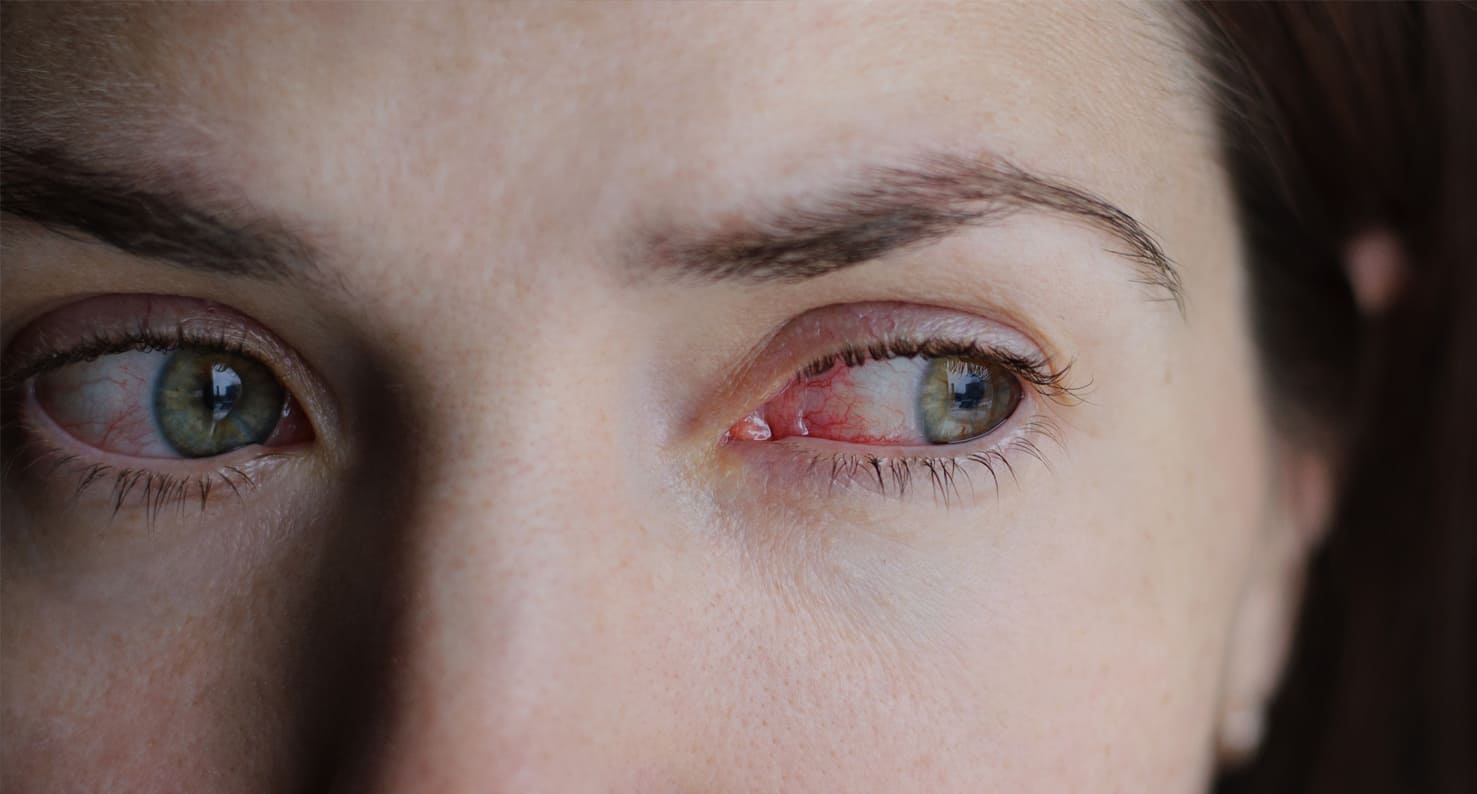How to Know If You’re Suffering From a Contact Lens-Related Infection
Published by on February 6, 2018
At Kugler Vision in Omaha, Nebraska, we know that millions of people wear contact lenses safely every day, but many also put their eyes at risk through improper contact lens care or overuse. If you wear contact lenses, it is important to understand that there is an increased risk of eye infection associated with their use. It’s crucial that you recognize the symptoms of a contact lens-related infection, understand the causes of these infections, and know how to prevent future eye infections.
Contact Lens-Related Infection

The Centers for Disease Control and Prevention (CDC) recently released a report showing there are almost 1 million doctor visits in the United States every year for eye infections related to improper contact lens care.
Keratitis is the most common eye infection associated with contact lens wear. Keratitis occurs when the cornea – the clear, front part of the eye – becomes infected. In extreme cases, keratitis can result in scarring of the cornea, which affects the quality of your vision. If the cornea is severely scarred, a cornea transplant may be needed to see clearly again.
What Causes Eye Infections?
Unsafe use of contact lenses can trigger serious eye injuries. Other causes include:
- Sleeping in your contact lenses
- Using the same pair of contacts for too long
- Using extended-wear lenses (even when used as directed)
- A buildup of microbes under the contact lens
- Infection from herpes virus
- Presence of bacteria or fungus on or around the contact lens
- Poor hygiene – not keeping lenses or cases clean, or reusing or topping off contact lens solution
Contact Lens-Related Infection Symptoms

Common symptoms of a contact lens-related infection include:
- Sudden blurry vision
- Unusual redness of the eye
- Worsening eye pain – even after removal of the contact lens
- Unusually watery, tearing eyes or discharge
- Light sensitivity
- Foreign object sensation in the eye
If you are experiencing any of the symptoms, it is important that you contact the vision experts at Kugler Vision as soon as possible. Eye damage occurred in nearly 20 percent of contact lens-related eye infections reported to the U.S. Food and Drug Administration over the last 10 years.
Contact Lens-Related Infection and Contact Lens Intolerance (CLI)
Contact lens intolerance (CLI) is the term used to describe the point at which the eye can no longer tolerate the foreign body (contact lens) that has been in place, and the eye begins to show signs of rejection. Contact lens wearers suffering from CLI are no longer able to apply a contact lens to their eye or wear contacts for any extended time without pain, discomfort, or injury. Those who have experienced one or more contact lens-related infections are more likely to develop CLI, and these infections are known to speed the onset and severity of CLI symptoms.
If you believe you are suffering from CLI, please contact Kugler Vision today. At Kugler Vision, patients undergo a series of comprehensive tests to determine the best treatment for CLI.
How to Prevent Eye Infections
So now that you know improper wear and care of contact lenses can cause eye infections that can lead to serious, long-term damage, what can be done about it? To prevent eye infections, we recommend that contact lens wearers follow these simple tips:
- ALWAYS wash hands with soap and water and dry well before handling contact lenses
- Take contacts out before going to bed, showering, or swimming
- Rub and rinse contacts in disinfecting solution each time they are removed
- Rub and rinse the contact lens solution case, dry with a clean tissue, and store upside down with the caps off after each use
- Replace contact lens cases at least once every three months
- NEVER “top off” remaining solution in your lens case – always refill with fresh solution
- Carry a backup pair of glasses in case contact lenses have to be taken out
Adequately caring for contact lenses is inconvenient. We get it. Life gets busy. Sometimes, even though the tips above are relatively simple, it can be hard to be disciplined and follow them – especially when we’re rushed or tired.
Luckily, there is an easier, safer way. Imagine not having to follow these rules anymore or even wear contacts at all. At Kugler Vision, our mission is to allow you to live a life without barriers, a life of freedom, and a life without the daily hassles of contact lenses or glasses.
Laser vision correction, like LASIK, allows you to strip away the prosthetic vision aids you’ve relied on, removing that inconvenient layer between you and how you view and experience the world!
Why Choose LASIK?

If you are over 18 years old and currently wear contact lenses, it’s likely you don’t have to anymore. There’s a good chance you’re a candidate for a vision correction procedure. See the world clearly without the hassles of contacts or worrying about eye infections due to poor contact lens hygiene by having LASIK.
Approximately 90 percent of people who wear contact lenses or glasses are eligible to have their vision corrected with laser vision correction. The benefits of LASIK are endless.
- LASIK is safer than the alternatives like contact lenses.
- LASIK is affordable. In fact, LASIK is far less expensive than the never-ending cost of contact lenses and glasses.
- LASIK corrects nearsightedness, farsightedness, and astigmatism.
- LASIK is a life-changing, transformational experience allowing you to live life without visual barriers.
LASIK has already transformed the lives of millions of people just like you. But, is LASIK right for your eyes? Find out if you’re a LASIK candidate by taking our online LASIK self-test, or call us at 402.558.2211 to schedule a consultation.

Lance Kugler, MD, is a specialist in LASIK and vision correction surgery and CEO of Kugler Vision. A proud Omaha native, he is passionate about improving lives through clear vision. Dr. Kugler serves on several national boards, and his practice is recognized internationally as a center of excellence. Dr. Kugler is one of the original founders of the Refractive Surgery Alliance, an international organization comprised of over 350 of the world’s leading vision correction surgeons; he also served as its first president. In 2019, Dr. Kugler was selected as a TEDx speaker, and delivered a talk in Omaha about the worldwide epidemic of nearsightedness and refractive solutions. Dr. Kugler is an Associate Professor of Refractive Surgery at the University of Nebraska Medical Center’s Truhlsen Eye Institute, has been published in many medical journals, and participates in numerous clinical studies to advance the field of vision correction surgery. Additionally, Dr. Kugler is proud to be a Board Certified Fellow of the World College of Refractive Surgery & Visual Sciences. Dr. Kugler and his wife are proud parents to five active kids. When he has a spare moment, he enjoys skiing, tennis, travel, and fine coffee.




Leave a Reply